Asus Zenbook S 13 OLED (2022) Review
A 5-star laptop with a new AMD chip
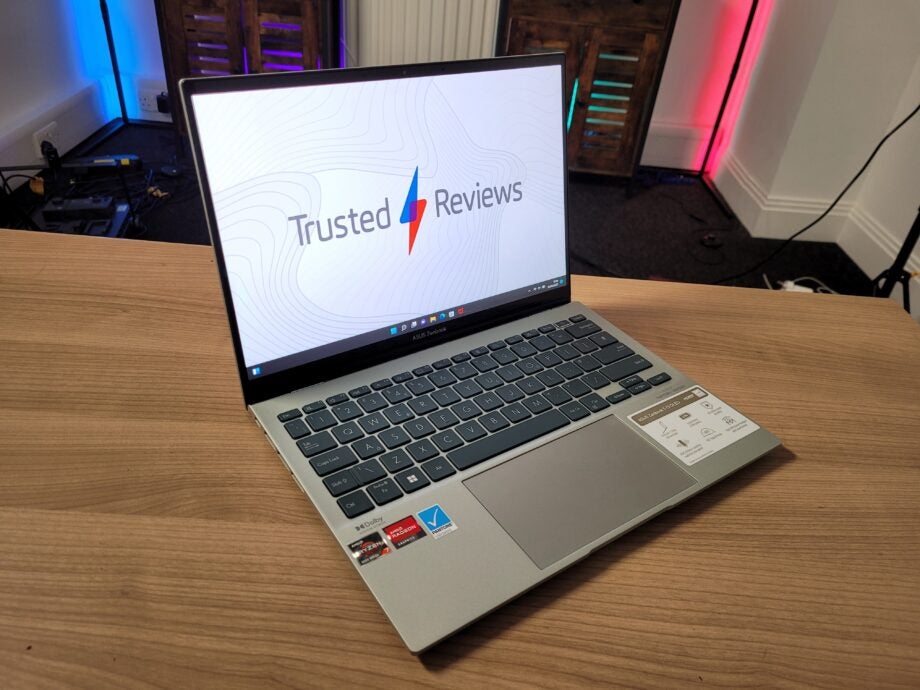

Verdict
The Asus Zenbook S 13 OLED is one of the best laptops I’ve ever reviewed. Its cutting-edge AMD chip is super-speedy, even capable of playing games, while the high-resolution OLED display is breathtaking for video. Its fans can get irritatingly loud under strain, and the lack of USB-A ports is irksome – but those are minor blemishes on an otherwise fantastic all-rounder laptop.
Pros
- Excellent performance, even for gaming
- Dazzling OLED screen
- Remarkably thin and light
- Great battery life
Cons
- Poor port offering
- Can run hot and loud under strain
Availability
- USARRP: $1299
Key Features
- AMD Ryzen 6000 processorFeatures the new AMD chip, which boosts CPU and GPU performance substantially compared to previous iterations
- 2.8K OLED displayThe OLED screen is vibrant, while the 2.8K resolution ensures a sharp display
- Weighs just 1kgThis laptop is extremely portable and easy to carry on the commute to work
Introduction
The Asus Zenbook S 13 OLED is a cutting-edge laptop in more ways than one.
First, it comes packing a processor from AMD’s new Ryzen 6000 family. AMD claims its new chip offers improved processing speeds while also delivering a substantial upgrade to the integrated graphics performance.
However, Asus isn’t relying solely on the specs here, since this laptop also sports a top-class design. The Zenbook S 13 OLED is wonderfully slender, weighing just 1kg for an ultraportable design. And last but not least, Asus has whacked in an OLED panel for good measure. It’s hard to think of a modern feature that hasn’t been included.
Even more impressively, Asus has confirmed the starting price to be a very affordable $1099, making this a fierce competitor to the MacBook Air M1 and Dell XPS 13 OLED. But is the Zenbook S 13 OLED good enough to be considered one of the absolute best laptop options around? Here are my thoughts.
Design and Keyboard
- Basic styling is a little bland
- Remarkably thin and light
- Port selection is poor
The Asus Zenbook S 13 OLED has a very simple design, with the only eye-catching feature on the lid being Asus’ new triangular logo – which gives me serious Star Trek vibes.
The main chassis flaunts the same simplistic style, with a plain metal deck preferred over the more eye-catching, patterned design of the Dell XPS 13 OLED, for example. You could accuse the Zenbook of lacking personality, but there’s no denying that it looks sharp.
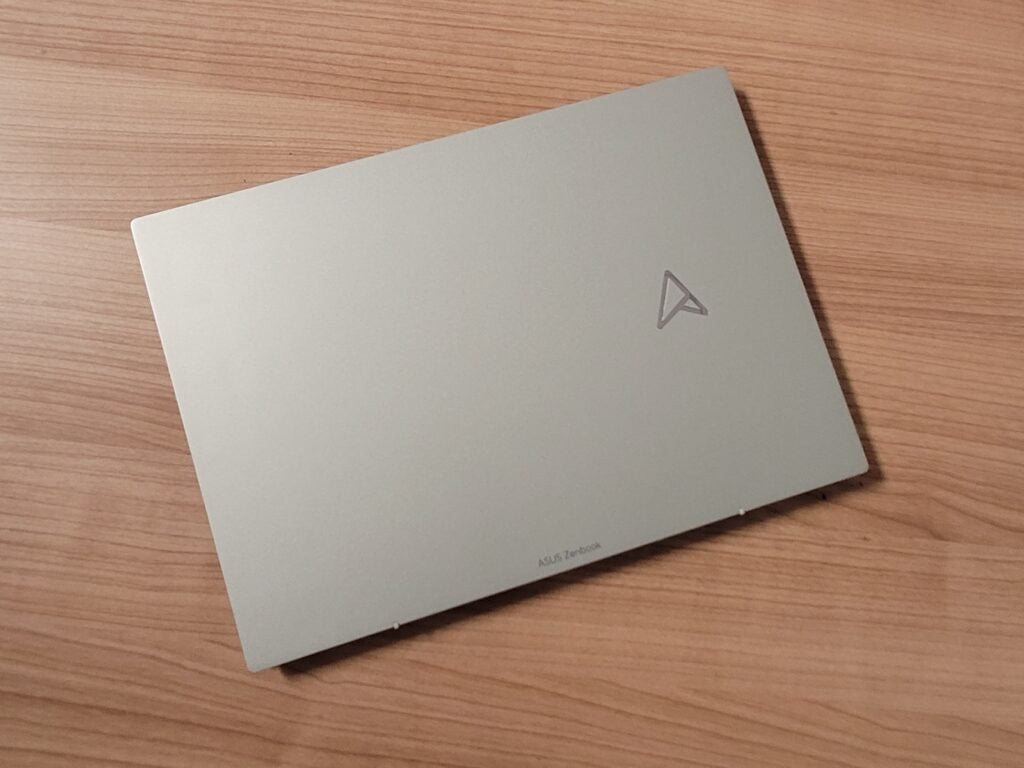
It is at least available in a range of colour options, including Ponder Blue, Aqua Celadon, Refined White and Vestige Beige (pictured here). That’s arguably an even better selection than what Apple offers with the new MacBook Air, allowing you to at least add a little personalisation.
But the most impressive aspect of the Zenbook’s design is how slender it is. Sporting just a 14.9mm frame, it’s about the width of my finger. Such a slim build has ensured this laptop is ridiculously lightweight, weighing a dainty 1kg; it’s over 200g lighter than the MacBook Air M2.
I can comfortably pick it up in one hand, and I have hardly noticed it in a bag during the commute. Asus has used a magnesium aluminium alloy to achieve this lightweight design; but that does mean it isn’t quite as sturdy as a pure aluminium build. Personally, I didn’t find this problematic – it’s a compromise I can accept for this level of portability.
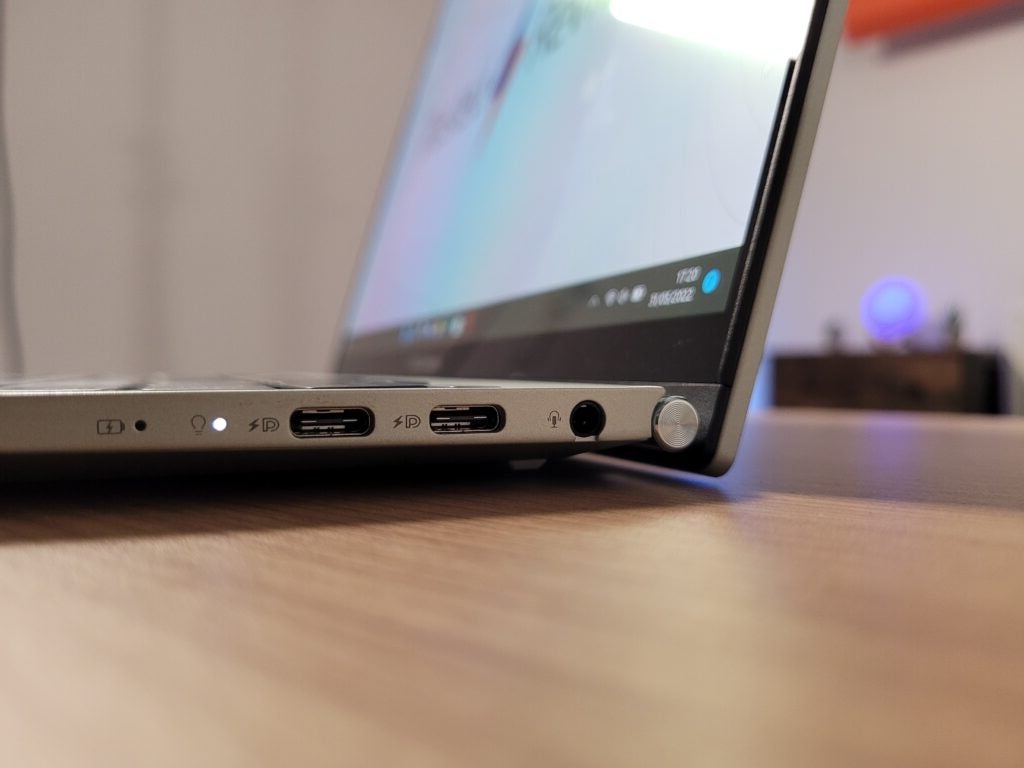
Asus has also added its ErgoLift hinge, which pushes the laptop’s rear up off the table to improve airflow beneath, while also creating a more comfortable typing angle. It may sound like a minor feature, but it makes a significant difference.
The port selection is arguably the Zenbook S 13 OLED’s greatest weak point – you get three USB-C ports and a headphone jack, and that’s it. I’d have welcomed at least one USB-A port for wired peripherals, but Asus would probably argue the laptop is too thin for such an inclusion, while also providing a USB-C to USB-A adapter in the box.
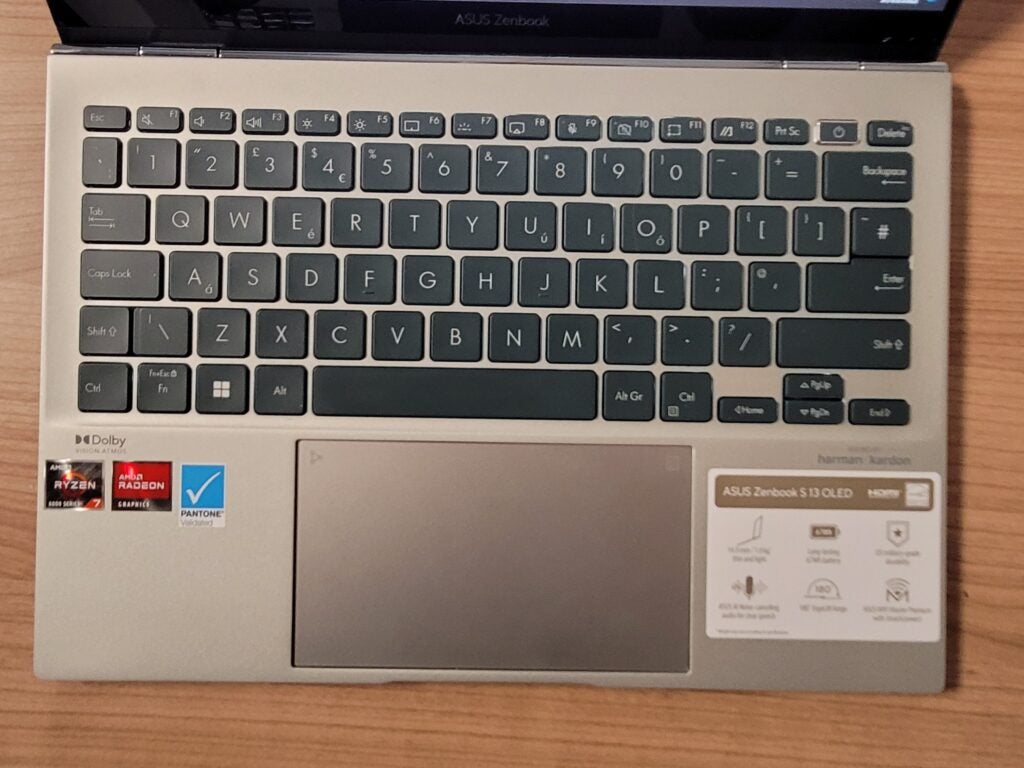
On the bright side, the keyboard is surprisingly fantastic. Keys offer deep and satisfying presses, and are chunky enough to reduce the risk of typos. You also get a fingerprint sensor embedded into the power button to make the sign-in process pleasingly snappy, as well as a camera kill switch to offer peace of mind that someone isn’t watching you.
The only blemish on the keyboard is the lack of a number pad, but Asus makes up for this with a virtual number pad that flashes up on the trackpad when pressing a button in the top-right corner. It’s an ingenious addition that will be a life-saver for those who work with numbers. The trackpad is of a decent size, too, being sensitive and responsive enough for a seamless experience.
Display
- OLED panel looks amazing
- High 2880 x 1800 resolution
- Glossy screen is quite reflective
OLED screens are in vogue right now, delivering perfect dark blacks to ensure a dazzling contrast that elevates the overall picture quality. I’ve tested a few OLED laptops now, including the Dell XPS 13 OLED and Asus ZenBook Pro 14 Duo OLED, and it’s clear that they offer a substantial upgrade on the standard LCD screens typically found on a laptop.
The Asus Zenbook S 13 OLED is no different in this regard, with vibrant colours shining spectacularly on the 13.3-inch screen. I watched Better Call Saul on this laptop, and I was enamoured by the Albuquerque desert backdrops, with the cloudless blue sky looking brighter than ever.
Of course, the high resolution (2880 x 1800) plays a part in this superb picture quality. Video looks sharper, with less obvious pixellation in supported content – of which there is plenty available on the likes of Apple Plus, Disney Plus and Netflix.

To back up my thoughts, I used a colorimeter to collect some benchmark data. I recorded a 361.31-nit brightness, which is a distance off Asus’ own claims, but still easily bright enough for use indoors. But I’m a little concerned about the screen’s glossiness; it’s so reflective that it could become problematic for outdoor use.
The colorimeter also shows the panel to have exemplary colour coverage, achieving 100% in sRGB, 96% in Adobe RGB and 97% in DCI-P3. This essentially means that this laptop is capable of producing enough colours to present any photo, image or video accurately – you shouldn’t see any noticeable distortion here, making it an ideal laptop for professional-grade content creation. The Asus Zenbook S 13 OLED performed better in this regard than laptops twice as expensive.
This Zenbook is also available with a touchscreen and stylus support. All in all, this is as good as it gets for a laptop screen. Asus could have hiked up the resolution to 4K, but that would have made it more expensive and reduced its battery life. So my only real gripe with the laptop screen is the glossy surface.
Performance
- New AMD chip is faster than Apple M1
- Capable of running modern games
- Can become hot and loud under strain
The Asus ZenBook S 13 OLED is the very first laptop I’ve tested that features a processor from AMD’s latest Ryzen 6000 generation. My review model is powered by AMD Ryzen 7 6800U with 16GB of RAM, which is the most powerful configuration. The laptop is also available with a Ryzen 5 6600U and 8GB of RAM.
The performance was excellent during testing, displaying a clear, noticeable improvement over other laptops I’ve reviewed recently. I had multiple web browser windows open simultaneously and various apps running in the background, and I didn’t notice any slowdown. The laptop’s fantastic graphics performance even allowed me to dabble with gaming and photo editing, although I’ll delve deeper into that later.
| Asus Zenbook S 13 OLED | Dell XPS 13 OLED | MacBook Air M1 | |
| CPU | AMD Ryzen 7 6800U | Intel Core i7-1185G7 | Apple M1 |
| Geekbench 5 single/multi | 1482 / 7509 | 1465 / 5424 | 1731 / 7308 |
| PCMark 10 | 5823 | 5042 | N/A |
| 3DMark Time Spy | 2270 | 1459 | N/A |
The new Ryzen processor secured fantastic results in our benchmark tests, with its multi-core Geekbench 5 score beating both the Intel Core i7-1185G7 and Apple M1 processors. That’s a jaw-dropping result, especially considering the Apple M1 chip was previously considered the fastest Ultrabook processor.
There’s a big caveat with these record speeds, though – both Intel and Apple are in the process of launching even more powerful notebook chips. I’ve already started testing the Intel Core i7-1260P inside the Samsung Galaxy Book 2 Pro 360, and it achieved an astounding multi-core Geekbench 5 result of 9178. And while I haven’t reviewed the new MacBook Air yet, the M2 chip is said to offer a 18% CPU performance boost compared to the M1.
This all means that the Asus Zenbook S 13 OLED will soon be leapfrogged as the most powerful Ultrabook laptop that we’ve reviewed. But that shouldn’t be a concern, since this is still comfortably powerful enough to blast through day-to-day tasks and more.
The one area where AMD may hold an advantage over Intel is with regards to integrated graphics performance. The Asus Zenbook S 13 OLED excelled here, enabling me to play big-budget games without the need of a discrete GPU.
With balanced/medium graphics settings, I was able to run Horizon Zero Dawn at 28fps and Dirt Rally at 72fps – this means that as long as you’re happy to tweak the graphics settings, the Asus Zenbook S 13 OLED is more than capable of being a substitute for a certified gaming laptop, or even take on heavy graphics workloads for content creation such as video editing.
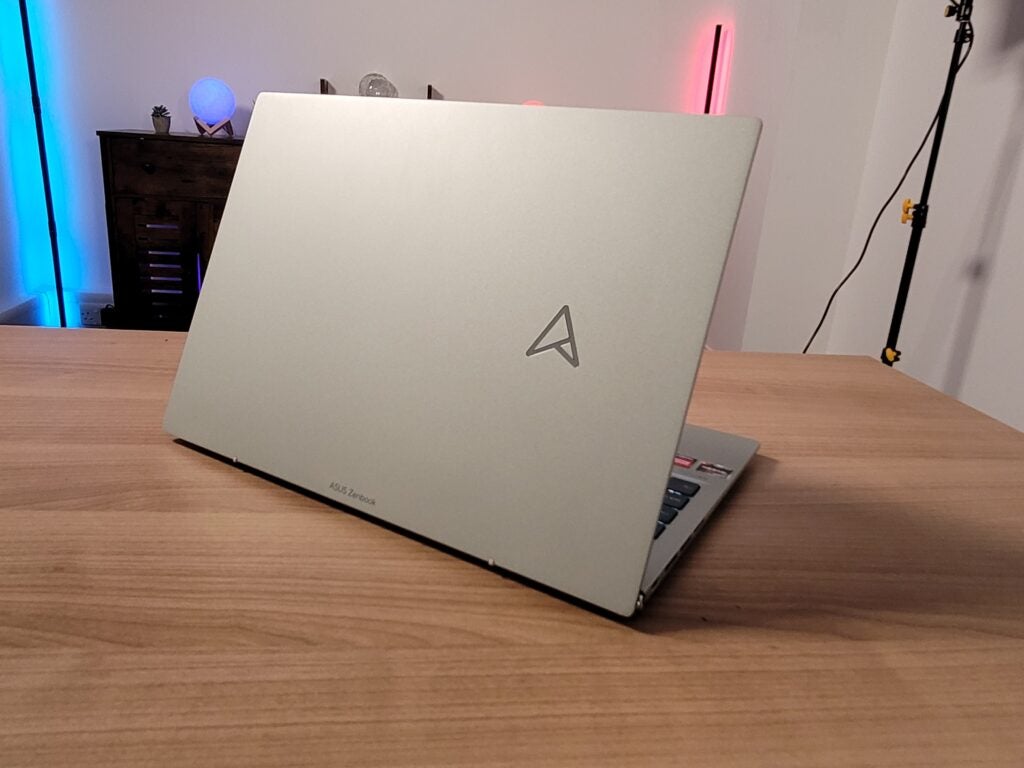
It’s worth noting that the laptop’s fans will become distractingly loud when the laptop is asked to do any heavy-lifting, while the chassis surrounding the keyboard will become hot to the touch, too. Asus has made sure the laptop doesn’t become too warm anywhere that your hands will naturally rest while typing, but it may make you hesitate to rest this laptop on your lap.
The fact that the new Ryzen chip also supports PCI Express 4.0 means Asus can make use of more cutting-edge SSDs. This has resulted in a big performance boost, with read and write scores of 6693MB/s and 3967MB/s respectively. The former is double the speed of your average laptop SSD, which means this laptop is incredibly fast at booting up and launching downloaded software and apps. Storage capacity is good, too, with Asus offering both 512GB and 1TB configurations.
Battery Life
- Lasts over 13 hours on a single charge
- Far better battery life than the Dell XPS 13 OLED
With the Asus Zenbook S 13 OLED flaunting such excellent performance and a high-resolution display, I was concerned that this laptop would struggle to surpass the target 10-hour mark. It turns out my worries were misplaced.
During our benchmark test (which sees us dial down the screen brightness to 150 nits and run a PCMark 10 benchmark), the laptop managed to keep on chugging for a remarkable 13hrs 26mins.
In the same test, the Dell XPS 13 OLED managed only 7hrs 22mins, which shows just how efficient the new AMD chip is. The Asus laptop easily lasted the working day, so you won’t need to worry too much if you forget to bring the charger into the office one day.
Latest deals
Should you buy it?
You want to play games on a lightweight laptop The Asus Zenbook S 13 OLED may not be a proper gaming laptop, but it’s more than capable of playing modern titles after tweaking the graphics settings. This is a great choice for those who want a lightweight productivity laptop on which they can also play games on the side.
You care about ports The biggest issue with this laptop is the lack of port options. None of the USB-C connections support Thunderbolt 4, and there isn’t a USB-A or HDMI port in sight. You’ll have to rely on the bundled dongle to use the likes of USB sticks and old wired peripherals.
Final Thoughts
The Asus Zenbook S 13 OLED is the first laptop I’ve seen in years to seriously challenge the Dell XPS 13 and MacBook Air as the very best ultraportable productivity laptop. The new AMD chip is a big factor here, boosting the CPU performance, GPU performance and battery life to new heights. The high-resolution OLED screen is also impressive for streaming video and scrolling through Instagram photos.
This laptop isn’t perfect: the port offering is poor, while the fan noise can become annoying under intensive workloads. But it’s difficult to be too critical of a laptop that’s packed with so many top-class features, and that comes flaunting even better performance than the MacBook Air M1. If you want an all-rounder Ultrabook, the Asus Zenbook S 13 OLED is one of the absolute best options available.
How we test
Every laptop we review goes through a series of uniform checks designed to gauge key things including build quality, performance, screen quality and battery life.
These include formal synthetic benchmarks and scripted tests, plus a series of real world checks, such as how well it runs popular apps.
We used as our main laptop for at least a week.
Tested the performance via both benchmark tests and real-world use.
We tested the screen with a colorimeter and real-world use.
We tested the battery with a benchmark test and real-world use.
FAQs
Does the ZenBook S 13 OLED have a touchscreen?
Yes, a touchscreen is available and it even supports a stylus.
Zenbook laptops usually offer a greater number of features and a more premium design – but they also tend to be more expensive.
Trusted Reviews test data
You can see a summary of the test data we collected and how it compares to the Zenbook’s XPS rival in the table below.
Full specs
You can see the laptop’s full specs and how they compare to its direct rival in the table below.
Sustainability
TrustedReviews’ holds the fact that global warming is not a myth as a core value and will continuously endeavor to help protect our planet from harm in its business practices.
As part of this mission, whenever we review a product we send the company a series of questions to help us gauge and make transparent the impact the device has on the environment.
We currently haven’t received answers to the questions on this product, but will update this page the moment we do. You can see a detailed breakdown of the questions we ask and why in our sustainability info page.








